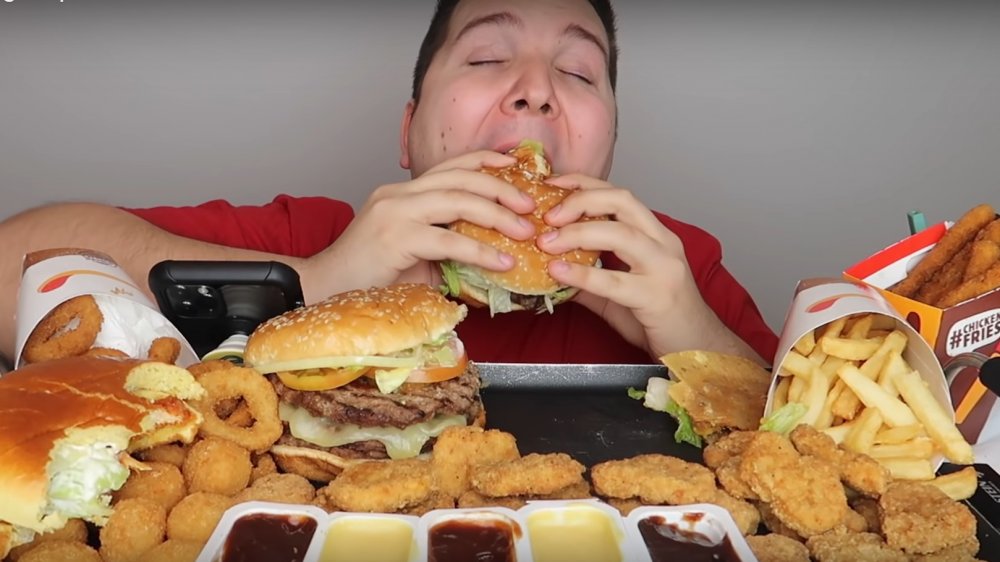The Untold Truth Of Mukbang
Mukbang. Yeah, it sounds like an NSFW word you'd never punch into your computer's search bar in the presence of other people. We get it. It's a foul-sounding word that brings about cringes when you ask people if they know what it means. However, it's exactly the opposite of the gratuitously explicit corner of the internet you might expect.
So, what exactly is mukbang? Punch that seven-letter word into YouTube and you'll find thousands of videos of people eating. That's right. Just... eating. And they're eating a ton of food. It sounds weird, and honestly, it kind of is. Watching someone eat doesn't sound like it could offer any kind of entertainment or intrigue, but once you take a deep dive into the world of "mukbangers," you realize there's a massive sect of society that actually loves watching hosts stuff their faces with lots and lots food.
You might want to add "mukbang" to your vernacular because this trend is blowing up quicker than an Eminem diss track. This is the untold truth of mukbang.
A lot of people watch mukbang
How many people could really be into watching others overindulge in fatty, greasy deep-fried foods while sitting in front of a camera chewing and smiling? As it turns out, millions of people love it. And let's be honest, it seems like an unusual thing to dip your toes into. But, that doesn't mean it's bad. It's a form of entertainment that just recently tapped into an eager niche.
Let's get down to actual numbers. Sure, it's easy to say "a lot" of people are into anything, but the proof is always in the pudding, and in the case of mukbang, the pudding is enormous. For example, one mukbanger from China named Mi Zijun had a mind-boggling 6.4 million subscribers on a YouTube-esque site called Weibo as of August 2018. That's an absurd amount of people who literally just watch her eat a pretty big meal.
MommyTang is a mukbanger with nearly 500,000 YouTube subscribers, and Stephanie Soo has nearly two million — which means tons of people see them with mouthfuls of food every night.
If popularity is your goal, mukbanging just might be the answer.
Mukbang started in South Korea
Where exactly did this whole mukbang thing start anyway? If you're thinking it sounds like something that came from overseas, you're right. The word 'mukbang" is of South Korea origin, and that's exactly where the whole craze started sometime around 2010. Even though it sounds like it might be some sloppy fetish genre, the word is totally tame.
The word is a portmanteau — a word made up of the smashing together of two other words — and when you break it down, it makes total sense. "Muk-ja" means "eating," and "bang-song" means "broadcast." So, the word means "broadcast eating," which is exactly what it is. People broadcasting themselves over the internet while they stare into the camera and consume a (very large) meal.
And chances are, even if you know what the word means, you're saying it wrong. It doesn't sound like it looks — the word is actually pronounced "mook-bong" or "moak-bahng."
Some mukbangers make a ton of money
Most people slave through their nine-to-five jobs trying to earn a living. But, the lucky bunch of mukbangers who run super popular YouTube channels often have no need to work regular hours. Believe it or not, simply binge eating in front of a camera on a regular basis can bring a boatload of money. Why would someone do anything else?
Attending college might help you earn a hefty paycheck every year, but nowadays, slamming down plates of food can earn you a better living than someone who busted their hump for a four-year degree. Take Park Seo-Yeon, for example. She's one of South Korea's top food bloggers and rakes in nearly $9,000 a month for her YouTube channel.
Look, having a degree can be important, but becoming a popular mukbanger pays the exact same bills. Maybe even more.
Mukbang takes a toll on the human body
It can't be healthy to stuff hashbrowns, chicken nuggets, fast-food burgers, and a variety of dipping sauces into your body in one session, right? No, it isn't.
Nowadays, people pride themselves on how much kale they consume and how many carbs they leave out of their daily diet. But, many mukbangers thrive on saturated fats and caloric intakes. One popular American mukbanger who goes by Nicokado Avocado puts his body through hell for most videos. He says nhaling thousands of calories in a sitting often leaves him sick — and crying on the toilet.
Dietician Theresa Kinsella told The New York Times, "The short-term health risks are physical discomfort, gastrointestinal distress, lethargy and fatigue." She added that, in the long-term, mukbangers may see weight gain, heart disease, and diabetes.
Nicokado weighed 140 pounds before he discovered mukbanging, but ever since his slew of videos, he now clocks in at 220 pounds. He claims he eats lots of greens outside of his videos, but an 80-pound weight increase proves that might not be enough to balance things out.
Some people watch mukbang for different reasons
People tune into the Food Network because there's something satisfying about watching others enjoy a meal. That's exactly why so many people tune into mukbang videos. Even though they're not the ones indulging in the massive feasts, watching someone else shovel their favorite foods into their mouths is almost as satisfying. But, not everyone tunes in because they want to watch YouTubers eat.
A good chunk of the people watching mukbangers overeat is for reasons relating to ASMR. For those who aren't familiar with the acronym, it stands for Autonomous Sensory Meridian Response, and it's the name for a calming tingling sensation that affects the brain and spine. Some people find the sounds of chewing, sipping, and slurping extremely relaxing, and they fire up the videos for the sounds over the physical eating. There are even some people who find the videos sensual, and the visuals and sounds come together to offer a "near-pornographic experience."
Not every mukbanger understands the craze
Just because you're a part of a community like mukbang doesn't necessarily mean you totally understand the craze or the attention the community garners on a massive scale. People join groups because they have fun engaging with others who share the same interests, but even though someone's having a blast, they may not really get the point of it all.
Take mukbanger Bethany Gaskin, known as B-Love, for example. This is a woman who, night after night, treats viewers to a massive feast in front of her camera and leaves them satisfied. You might assume someone with such an immense following and passion for the activity would truly understand why someone tunes in to watch her shovel food down her gullet. Well, as it turns out, she doesn't really understand the craze. But hey, it makes her a bunch of money, and what she does understand is bills need to get paid and this is an enjoyable way to do it. "I don't understand it, but I just do it," Gaskin said. "To have people watch you eat, it's weird. But the numbers are looking good, the money is right, so I'm going to keep on doing it!"
Mukbang may have a darker origin
The whole idea of eating in front of a camera is said to have came about because the people of South Korea rarely dine alone, so when one does find themselves without company, they can simply tune into their favorite personality and "join" them in a meal. But, simply having the company to enjoy a meal may not actually be the reason for the mukbang popularity.
One explanation offered by Michael Hurt, director of cultural studies at South Korea's Busan University of Foreign Studies, has a somewhat grim theory as to why mukbang is becoming so popular, and it has to do with how we have decreased our face-to-face interaction with other people.
He said, "Korea is a society of the spectacle, and it's gotten to the point where social interaction can't happen—can barely be understood—without being mediated in some way. They have a different understanding of how media is used. It's become truly a part of life."
Bethany Gaskin is the mukbang shellfish queen
For those of us who love eating crustaceans and cracking open their exoskeletons to find the succulent treasure inside, we couldn't imagine actually making money doing so. Lobster and crab ain't cheap, and we expect to rack up a hefty bill eating them. But, what if you earned your salary simply by chomping down mouthfuls of delectable lobster tails and crab legs? Well, one woman does, and she couldn't be happier doing it.
Bethany Gaskin is a popular YouTuber widely known for eating shellfish online. On her YouTube channels Bloveslife and BlovesASMR Eating Her Way, she doesn't just tackle a one-pound lobster or a few measly crab legs during a video. This lady tackles a serious level of shellfish. She takes on massive Dungeness crab legs, several lobster tails at a time, and dozens of mollusks, all while talking into the camera about how amazing everything is. Once a child daycare owner, Gaskin now uploads daily videos of herself enjoying seafood feasts so exquisite it would make any seafarer green with envy.
Life is good when you're a mukbanger.
Fine Brothers Entertainment turned America onto the mukbang craze
How exactly did this whole "eating in front of a camera and uploading it to YouTube" craze get so popular around the world? In 2014, Reuters said (via CNBC) only about 3,500 people had the idea to upload videos of themselves eating to audiences. But, one year later, an entertainment duo called The Fine Brothers changed the entire landscape almost overnight. And, they did it because of one single video.
The pair uploaded a video to YouTube showing the reactions of Westerners to Korean mukbang videos. Some were horrified by the sheer quantity of food that was consumed in one single sitting, but others were fascinated. Whatever the opinions of the videos were, Americans began making the same type of thing. They saw the trend exploding and wanted to hop aboard the bandwagon to cash in on their favorite pastime: eating way too much food in one sitting.
American mukbang differs from Korean mukbang
Even though "mukbang" is a Korean word that Americans have embraced and try themselves, many of the videos from the states have some stark differences from the ones in Korea. Yes, they both involve people eating in front of a camera and broadcasting the action, but the American versions veer down a slightly different avenue.
Many American mukbangers (not all, just to be clear) like to talk while they eat. It's almost as if they guide the viewer through the taste sensations they're experiencing and explain how delicious each bite is, which is incredibly appealing to many mukbang fanatics.
Lots of videos are also pre-recorded and uploaded at some point after the host wraps their meal up. Most of the Korean videos, however, are actually streamed live during typical dinner hours so viewers can literally eat alongside their favorite personalities. Korean hosts mostly stay silent, as well. Americans tend to talk about themselves (how typical) and treat the camera as if it's a therapeutic way to get things off their chest.










